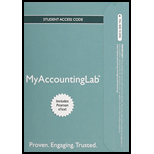
Concept explainers
Concept Introduction:
Perpetual Inventory System: The perpetual inventory system records and updates the inventory after each and every transaction. The inventory balance is updated after each transaction and it is kept up to date at every time.
FIFO method: FIFO Stands for First In First Out. Under this method, the units purchased first are assumed to be sold first and cost of goods sold is calculated accordingly. The ending inventory in the method includes the latest units purchased.
LIFO method: LIFO Stands for Last In First Out. Under this method, the latest units purchased are assumed to be sold first and cost of goods sold is calculated accordingly. The ending inventory in the method includes the oldest units purchased.
Weighted Average method: Under this method, the cost per unit of the inventory is calculated as weighted average cost per unit and the cost of goods sold and inventory is calculated with the help of weighted average cost per unit.
Requirement-1:
To determine: The Perpetual inventory record, the cost of ending inventory and cost goods sold for the month using the FIFO method
Requirement-2:
To prepare: The
Want to see the full answer?
Check out a sample textbook solution
Chapter 6 Solutions
MyLab Accounting with Pearson eText -- Access Card -- for Horngren's Accounting
- I need assistance with this general accounting question using appropriate principles.arrow_forwardGeneral accounting questionsarrow_forwardQuestion: Power Security Systems had sales of 3,000 units at $50 per unit last year. The marketing manager projects a 20 percent increase in unit volume sales this year with a 10 percent price increase. Returned merchandise will represent 6 percent of total sales. What is your net dollar sales projection for this year? Help mearrow_forward
- I am searching for the correct answer to this general accounting problem with proper accounting rules.arrow_forwardPlease provide correct answerarrow_forwardReciprocal Method Eilers Company has two producing departments and two support departments. The following budgeted data pertain to these four departments: Support Departments Producing Departments General Factory Receiving Assembly Finishing Direct overhead $400,000 $150,000 $45,000 $71,000 Square footage 2,700 5,400 5,400 Number of receiving orders 300 1,680 1,020 Direct labor hours 25,000 40,000 Required: 1. Allocate the overhead costs of the support departments to the producing departments using the reciprocal method. (Round allocation ratios to two decimal places. Round allocated costs to the nearest dollar. If an amount is zero, enter "0".) Allocation ratios: Square footage General Factory Receiving Assembly Finishing 0 0 Number of receiving orders 0.10 0 0.56 0.34 Allocations: Direct overhead cost General Factory Receiving Total General Factory Receiving Assembly Finishing $ $ $ $ 400,000 150,000 45,000 71,000 $ $ $ $ 2. Using direct labor hours, compute departmental overhead…arrow_forward
- Reciprocal Method of Support Department Cost Allocation Valron Company has two support departments, Human Resources and General Factory, and two producing departments, Fabricating and Assembly. Direct costs Normal activity: Number of employees Square footage Support Departments Producing Departments Human Resources $140,000 General Factory $340,000 Fabricating Assembly $114,200 $94,000 1,000 60 80 170 5,700 13,300 The costs of the Human Resources Department are allocated on the basis of number of employees, and the costs of General Factory are allocated on the basis of square footage. Now assume that Valron Company uses the reciprocal method to allocate support department costs. Required: 1. Calculate the allocation ratios (rounded to four significant digits) for the four departments using the reciprocal method. If an amount is zero, enter "0". Use the rounded values for subsequent calculations. Human Resources General Factory Proportion of Driver Used by Human Resources General…arrow_forwardPlease explain the solution to this financial accounting problem with accurate explanations.arrow_forwardGross Income $8.5 million & O. E 2.3 million.arrow_forward

 AccountingAccountingISBN:9781337272094Author:WARREN, Carl S., Reeve, James M., Duchac, Jonathan E.Publisher:Cengage Learning,
AccountingAccountingISBN:9781337272094Author:WARREN, Carl S., Reeve, James M., Duchac, Jonathan E.Publisher:Cengage Learning, Accounting Information SystemsAccountingISBN:9781337619202Author:Hall, James A.Publisher:Cengage Learning,
Accounting Information SystemsAccountingISBN:9781337619202Author:Hall, James A.Publisher:Cengage Learning, Horngren's Cost Accounting: A Managerial Emphasis...AccountingISBN:9780134475585Author:Srikant M. Datar, Madhav V. RajanPublisher:PEARSON
Horngren's Cost Accounting: A Managerial Emphasis...AccountingISBN:9780134475585Author:Srikant M. Datar, Madhav V. RajanPublisher:PEARSON Intermediate AccountingAccountingISBN:9781259722660Author:J. David Spiceland, Mark W. Nelson, Wayne M ThomasPublisher:McGraw-Hill Education
Intermediate AccountingAccountingISBN:9781259722660Author:J. David Spiceland, Mark W. Nelson, Wayne M ThomasPublisher:McGraw-Hill Education Financial and Managerial AccountingAccountingISBN:9781259726705Author:John J Wild, Ken W. Shaw, Barbara Chiappetta Fundamental Accounting PrinciplesPublisher:McGraw-Hill Education
Financial and Managerial AccountingAccountingISBN:9781259726705Author:John J Wild, Ken W. Shaw, Barbara Chiappetta Fundamental Accounting PrinciplesPublisher:McGraw-Hill Education





